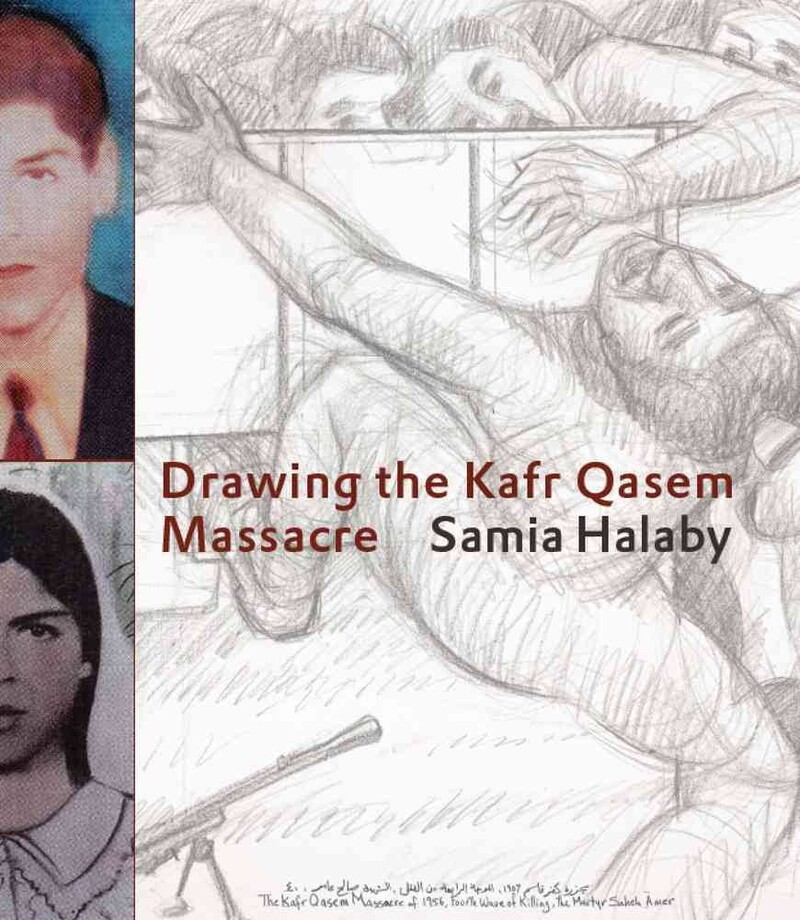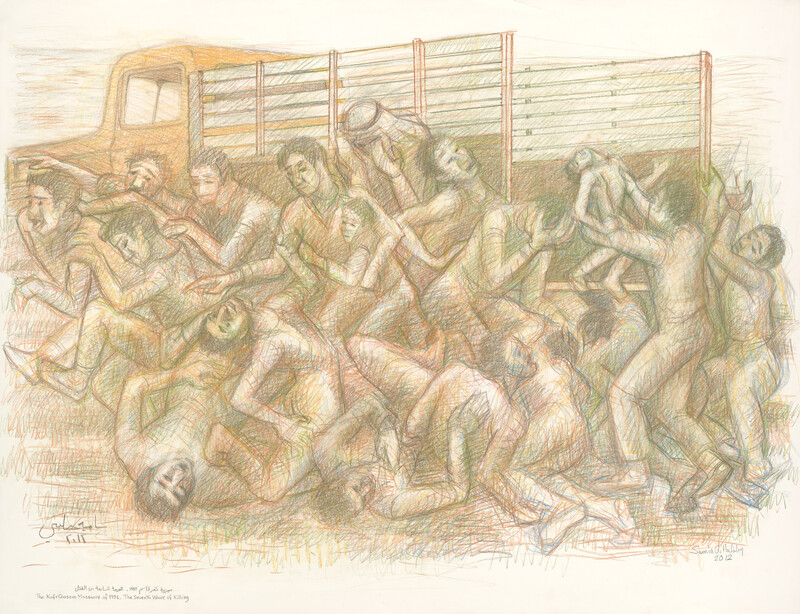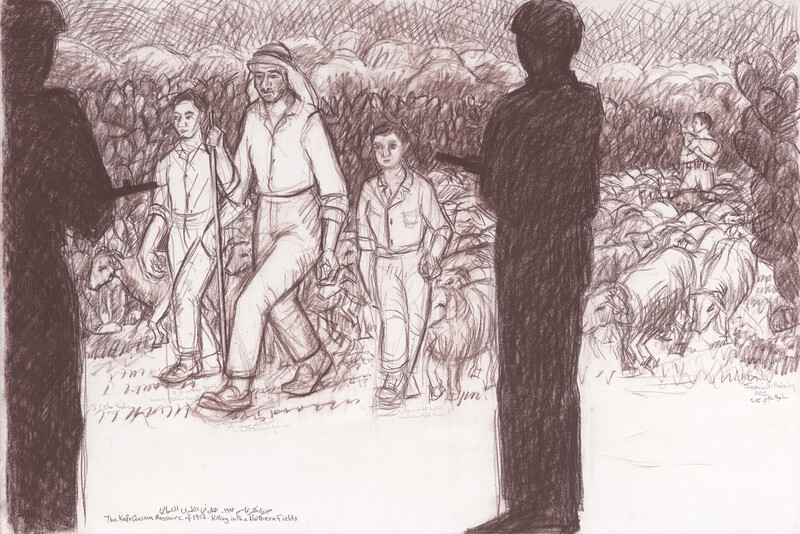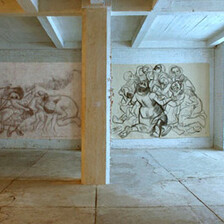The Electronic Intifada 15 June 2017

Drawing the Kafr Qasem Massacre, Samia Halaby, Schilt Publishing (2016)
For more than 20 years, Palestinian artist Samia Halaby has been researching, interviewing and traveling to assemble material and create art based on the Kafr Qasem massacre of 1956.
The killings in the village of Kafr Qasem – close to the boundary between Israel and the West Bank, then ruled by Jordan – were one of many committed by Israeli troops after the 1948 ethnic cleansing of Palestine.
In the case of the Kafr Qasem massacre, the context was the 1956 Suez Crisis, when Britain, France and Israel conspired to crush Egyptian President Gamal Abdel Nasser’s anti-colonial resistance, particularly his reclaiming of the Suez Canal from British rule.
In areas of the new state of Israel with large Palestinian populations – including the village of Kafr Qasem – curfews were announced in a bid to keep off the streets any supporters of Nasser.
But in a manner familiar to anyone who has spent time in the occupied West Bank, the curfews were often announced in a haphazard manner or not at all, and the Israeli forces claimed the right to attack anyone found outside after arbitrarily imposing the restrictions.
As a result, on 29 October 1956, 49 people were killed and dozens more wounded at Kafr Qasem. Many were women and children; most were agricultural laborers coming home from the fields. They were either not told of the curfew, or did not have sufficient time to reach safety. Hundreds more Palestinians were also massacred by Israeli troops in the towns and refugee camps of Khan Younis and Rafah in the Gaza Strip in the following days.
Halaby’s encounters with survivors of the Kafr Qasem massacre and their descendants inspired her to create a huge body of written, drawn and painted work.
Powerful and demanding memorial
To commemorate the 50th anniversary of the massacre, some of Halaby’s images, along with notes and other fruits of her research, were launched as an online exhibition in 2006.
Now, in conjunction with a touring exhibition – including the Birzeit University Museum in the West Bank and the Ayyam Gallery in Dubai – Halaby’s drawings and paintings, along with her artist’s notes, writings and raw materials such as photographs and news reports, are brought together in a lavish volume.
Comprising almost 300 pages, the book includes a foreword by Palestinian author Raja Shehadeh and historical background by the tireless chronicler of the Palestinian people’s struggle for their land, Salman Abu Sitta.
It’s not an easy book to peruse and read. It is a powerful and demanding memorial to the dead, with its endpapers presenting the reader with images of every person killed at Kafr Qasem at first opening – ranging from the photographs of ID cards to drawings conjured by Halaby herself where no photograph remains.

“The Yellow Truck of Ata Sarsour, Seventh Wave of Killing on the Western Road, The Kafr Qasem Massacre of 1956,” Conté crayon on paper, by Samia Halaby (Ayyam Gallery)
Halaby’s images in the book are a million miles away from the vivid, often abstract and florally bright paintings of some of her recent exhibitions.
Instead, the works contained in this book range from the sparest of preparatory sketches to finished paintings. Many are monochromatic or have very limited color palettes, reflecting the dusk and nighttime settings of most of the killings, and conferring both a sense of melancholy and a feeling of reportage or photojournalism.
“The Women Embrace in Death,” a monochrome drawing of village women described in the text as murdered during the final stage of the massacre, embodies this journalistic quality. Expressions of fear, pain and ultimately rest alternate across their faces, while the central figure of the group is captured, as if in a photograph, in the act of falling to the ground.
In “The Martyrdom of Ghazi and Abu Samaha,” another subtly shaded monochromatic drawing, the tall, handsome figure of 20-year-old Ghazi Mahmoud Darweesh Easa leads a small group of villagers carrying vegetables towards the village. Ghazi seems surprised by the Israeli Border Police before them while others appear concerned. The image conveys a powerful sense of dread as we view it with the knowledge of the events of the coming minutes.
Unflinching testimony
As Halaby writes, the research for the images included interviews with survivors and descendants about the events of the massacre – who ran where, who was killed in exactly what spot, from which angle the Israeli weaponry must have been fired. It also entailed learning about such gruesome facts as how the human body moves when shot and the anatomical logic behind how it crumples and falls.
While such attention to detail might appear voyeuristic, the overall impression is one of profound respect for the dead combined with a cold and bitter anger towards their killers. Through Halaby’s detailed research, the dead, almost erased from history, are restored to the world not just as victims of the massacre, but as humans with meaningful lives, even if cut short by violence:
“In the northern fields of the village, three shepherd boys were out watering the family’s flock of sheep not knowing that Israel had launched a surprise attack on Egypt just hours before … Ibraheem Easa, their uncle who was 35 years old, had learned of the curfew and left the safety of his home to bring them back … Israeli soldiers of the Border Police stopped them and immediately shot and killed Ibraheem, Abed and Abdallah. Sami saw them being shot and fell to the ground pretending to be dead, and survived.”

“Shephers of the Northern Fields, Killing in the Northern Fields, The Kafr Qasem Massacre of 1956,” Conté crayon on paper, by Samia Halaby (Ayyam Gallery)
After the massacre took place, the Israeli authorities imposed press silence and forced the remaining occupants of the village a year later to undergo what must have been a deeply traumatizing, and entirely fake, ceremony of reconciliation.
The villagers’ attempts to memorialize their dead have also been resisted, with commemorative marches often facing bans and police violence.
This book, with its many statements from the villagers themselves before the reader even reaches Halaby’s interpretation of the events, is a powerful and unflinching testimony both to the dead and to the stubborn survival of those left. The title page is followed immediately by a double-page spread of comments by witnesses and victims of the attack. One survivor reports how an Israeli officer told his men to “harvest” the unarmed workers lined up before them.
Another recounts: “My brother began crying … the soldier came and pointed the gun at his head and shot him … I swear by God he did not say a thing but hiccuped and hiccuped and he began to press, press on me … then he suddenly let go. And I knew he was dead and I continued to pretend to be dead, even though I was badly wounded.”
In the detailed research, the witness statements and the unrelenting images, the volume allows Halaby and her informants to ensure that, whatever attempts have been and will be made to erase memory, each minute of the Kafr Qasem massacre has been traced and recorded.
The book is simultaneously an aesthetic work, filled with Halaby’s immense skill and verve as an artist, and an object of defiant remembrance. Nothing can cancel out the brutality and terror of the events of October 1956, but Halaby’s art – be it online, in a gallery or in this superb book – makes sure that the victims of Kafr Qasem cannot be denied.
Sarah Irving is author of a biography of Leila Khaled and of the Bradt Guide to Palestine and co-editor of A Bird is not a Stone.






Comments
Halaby and Joe Sacco
Permalink Einar Steinn Valgarðsson replied on
Great review and seems a very interesting book. I'm curious as to whether Halaby is familiar with the works of Joe Sacco or he with hers, as he did his book Footnotes in Gaza on the massacres in Rafah and Khan Younis.